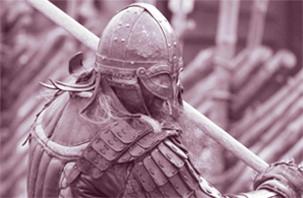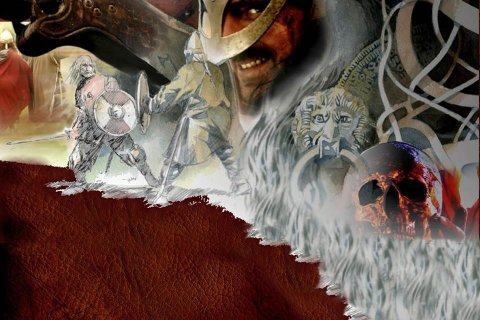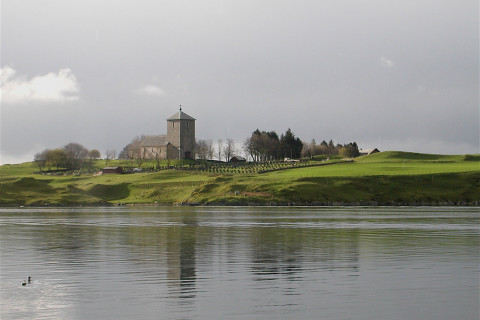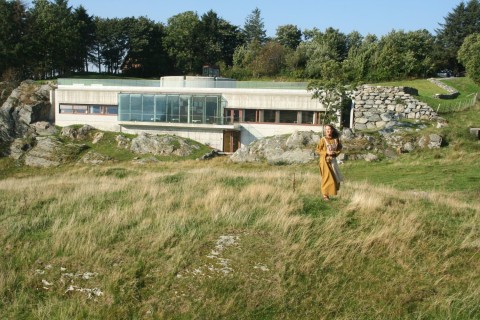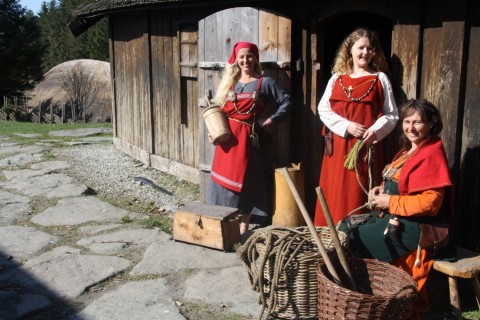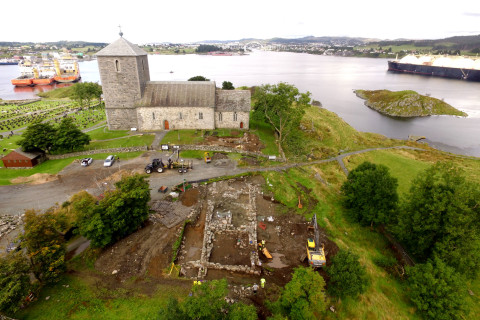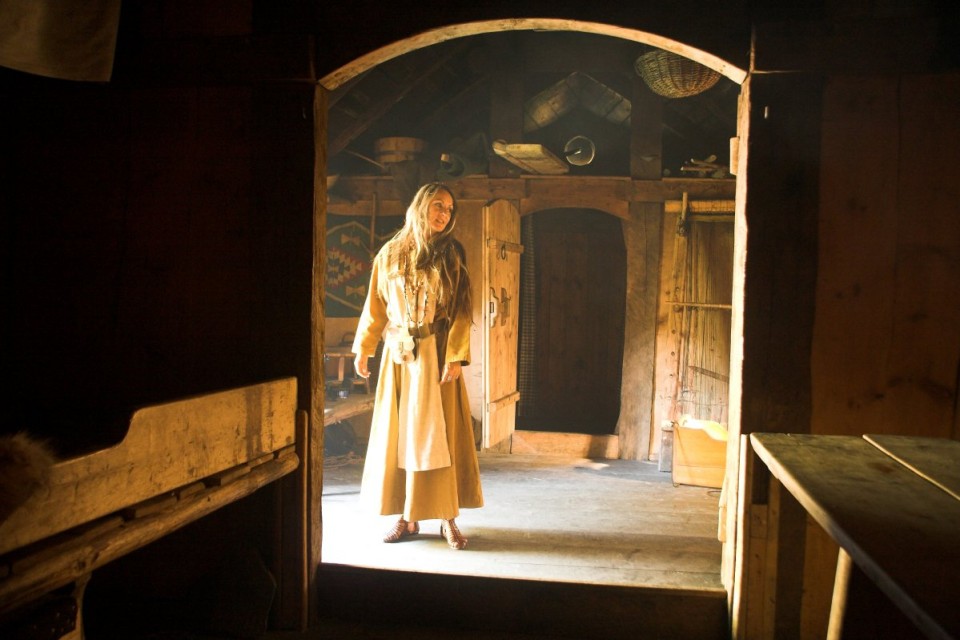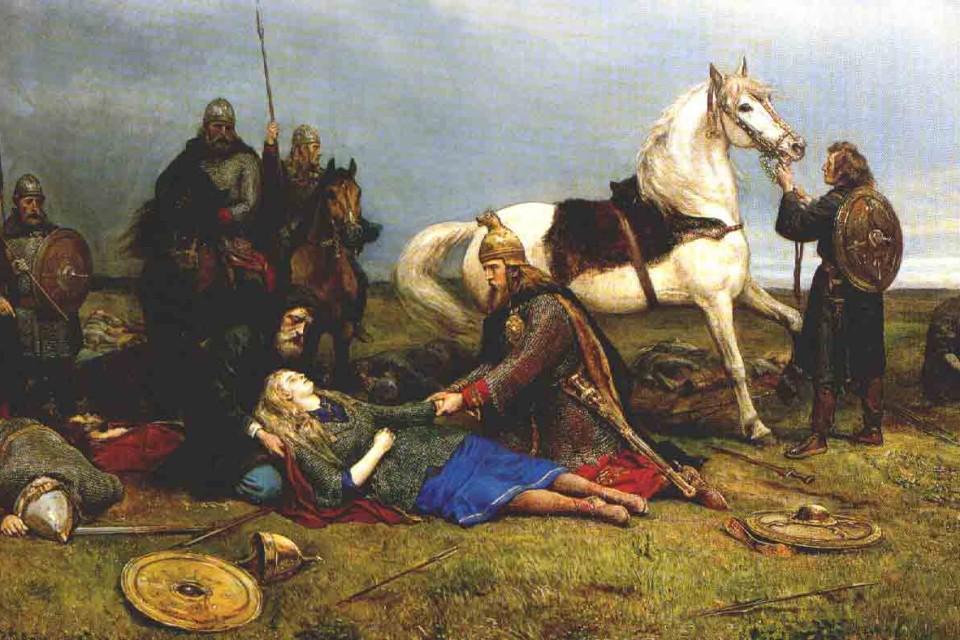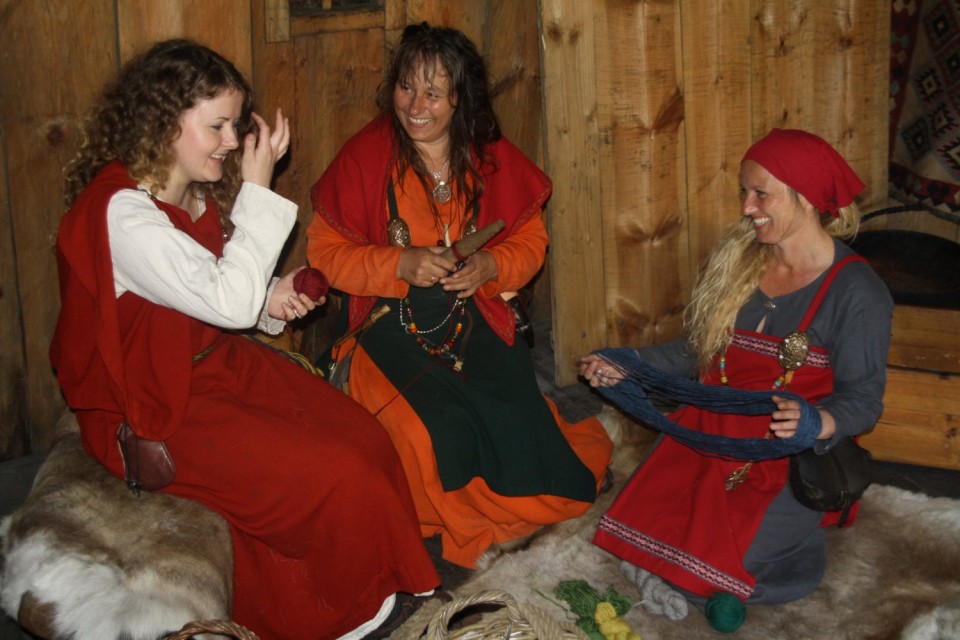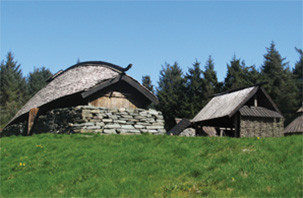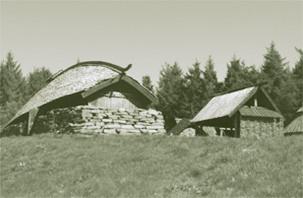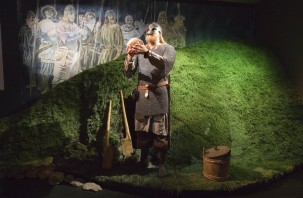Viking women
Text. Marit Synnøve Vea
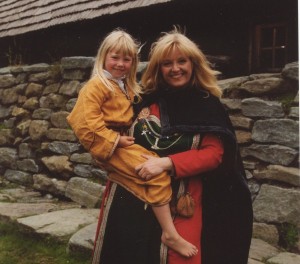
Women and men have different tasks and different roles. (Photo Marit S. Vea)
GENDER DIFFERENCES
There were great differences between men and women in the Viking Age, but the Viking women had a stronger position than women elsewhere in Europe at this time.
The social position and the work done by women were first and foremost connected with the family and the farm. The lady of the house was responsible for all the wealth of the farm and the household. This is symbolized with the keys that she carried with her. As manager of the household, the lady of the house had a lot of power.
Many men went on voyages as traders, explorers and warriors. Women stayed at home to take care of the household. While the men were on voyages, women also had to make decisions that normally were subject to male responsibilities.
Farm and land was the very foundation, also in the maritime Viking society. Therefore, marriage was first and foremost a political and economic arrangement between families. (See: LOVE AND MARRIAGE)
But women could also have other occupations than those connected with the farm. They could be rune- masters, scalds, priestesses, explorers and traders. Perhaps they also were warriors.

Olav Tryggvason proposes marriage to Sigrid the Haughty, who rejects him. ( Ill E. Werenskiold)
WOMEN IN THE SAGAS
In the sagas we meet strong, proud and independent women, many of them are pictured as willful, manipulating and often uncompromising. They seem to be brought up to be both self-conscious and eager for power. We also see that women are given away in marriage to confirm alliances between families. Young girls are married off to strangers. You would believe that such girls were brought up to be obedient and self-sacrificing.
It seems to be an ambiguity in the different roles that Viking women should fit into. Are we dealing with two completely different role models? Or could it be that the gender roles in the Viking Age were more multifunctional than expressed in the traditional picture of Viking women?
WHERE CAN WE TRACE VIKING WOMEN?
– Rune stones
It required both initiative and power to erect a rune stone. Still, some of the memorial stones are erected for a woman or by a woman, but much fewer than those mentioning men.
In Denmark there are about 220 memorial stones. For 23 of these stones, women are the sole commissioner.
11 stones are erected in memory of a woman.
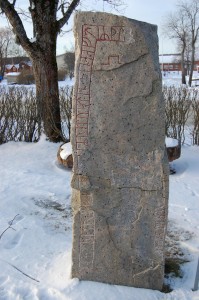
There were female runemasters. This one in Gävleborgs län is carved by Gunnborga, (Photo Wikimedia Commons)
Women are in most cases prized for other skills and qualities than men. Men are often prized because they have been on long voyages or because they are great warriors. Women are prized because of their housekeeping or other typical female skills
On the Dynna stone a mother tells this about her daughter:
”Gunvor, daughter of Thydrik, made a bridge in memory of her daughter Astrid. She was the handiest maiden in Hadeland”
A husband remembers his wife Odinisa by these words:
“The husband of Odinisa gives her these memory words: No better housewife will come to Hasselmyra to look after the farm“
In Ramsundberget Sigrid let these words about her father be carved into a flat rock:
“Sigríðr, Alríkr’s mother, Ormr’s daughter, made this bridge for the soul of Holmgeirr, father of Sigrøðr, her husband.”
On a rune stone on Rimsø a son carves his sorrow in stone: (ca 900 AD):
“Thore, brother of Enride, erected this stone in memory of his mother. Death of a mother is the worst that can happen to a son.”
From the Hälsingland runestone we also know the name of female runemaster – Gunnborga:
“Ásmundr and Farthegn, they erected this stone in memory of Thorketill of Vattrång, their father. Gunnborga the good coloured this stone.”
– Artistic expressions
We can get knowledge through artistic expressions like carvings, jewellery. picture stones, tapestries etc.
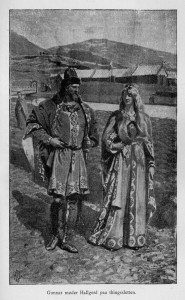
Gunnar meets Hallgerd at the Thing. Njål`s Saga. (Ill. Andreas Bloch)
– Contemporary foreign sources
We have some contemporary foreign account that also mentions Viking women. Most of them, both eastern and western, are astonished about the liberty of these Scandinavian women. ( See: LOVE – MARRIAGE)
– The Law and the Thing
The oldest parts of the laws were not written down until the 11th century. But laws are conservative and have elements that go further back in time. The thing (ON þing) was the legislative and judicial assembly.
The Allting was an old institution that existed long before the Viking Age. It was a sort of general meeting for a defined area for example a village. All free men had the duty to meet at the Allting. Women and disabled men could meet if they wanted to. This also had practical reasons. Scattered settlements and large distances meant that someone had to stay home and take care of the farm even though the Allting was set. And – the farm and the household was the women’s responsibility.
Eventually the Lagting, that applied to a larger area, was established. It was then inconvenient that so many should travel over large areas. Instead representatives or “send men” were elected. This happened probably in the time of Håkon the Good, around 950, and it may have been at this time that women’s “right to vote” disappeared. Nevertheless, a widow could still undertake public functions and meet at the Lagting instead of her husband
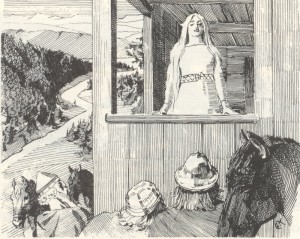
In Harald Fairhair’s saga, we hear that the young Gyda refuses to marry Harald until he has “united Norway into one kingdom.” (Harald Fairhair’s Saga, illustration E. Werenskiold)
According to the laws, women in Scandinavia had more rights than elsewhere in Europe. But they did not have the same rights as men. We must also take into consideration that the laws describe ideal conditions, how things are supposed to be, not what they really are.
Some examples:
– A man could become a King even if it only his mother was of royal blood
– It was possible for woman to inherit land from her parents, even though she only got half as much as her brothers. This is probably because a woman also received a dowry, corresponding to the other half of the inheritance, from her parents when she married.
– When a woman married, she brought a dowry with her into the marriage. The groom gave her a similar amount as “morning gift”. In case of a later divorce, the women should keep both of these as her property.
Harald Fairhair passed a law which gave the capital punishment “fredløshet” for prostitution
“For her sake he (Harald) at once protected the chastity of all by passing a law by which the rape of women was punished by exile or a fine of sixty marks which would cancel the exile. (Historia rerum Norvegicarum)
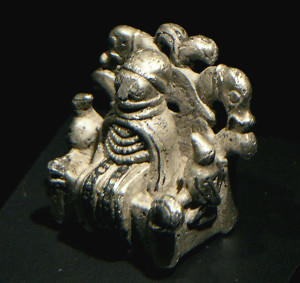
This figure, found in 2009, is commonly called Odin from Lejre. Is Odin dressed in women’s clothes? Or is it Freya or Frigg that sits in the high seat Lindskjalv? Grimnismål tells that “Odin and Frigg sat in Lidskjalv and looked out on the world” (Photo Wikimedia Commons
– Myths and religion
The Norse religion is crowded with female beings: They are goddesses, giantess, elves, nornes, valkyries etc.
Women were priestesses (gydjer) at the same level as men were priests (goder). Also as volver, a kind of shamanesses or seeresses, they were highly respected. It was Freya who taught the art of fortunetelling and magic (seiðr) to the gods. Both men and women could be engaged in seid, but normally it was practiced by women.
– In sagas and Norse poems
Women are described as strong-headed, proud, independent and vindictive. We also meet women who encourage the men to take revenge in order to keep up the honour of the family. One example is Sigrid Skjalgsdatter who gives Tore Hund the spear that has killed her son Asbjørn.
“Here is the spear which went through Asbjorn my son, and there is still blood upon it, to remind thee that it fits the wound thou hast seen on the corpse of thy brother’s son Asbjorn. It would be a manly deed, if thou shouldst throw this spear from thy hand so that it stood in Olaf’s breast; and this I can tell thee, that thou wilt be named coward in every man’s mouth, if thou dost not avenge Asbjorn.”
St. Olav was later killed with this spear.
In the matter of honour, the women themselves were in no danger of being killed. A man who laid hand on a woman had lost his honour, and he had damaged the honour of his family.
Sometimes the women also took revenge themselves. This is what happened to Gunnar from Hlidarende in Njåls saga:
Gunnar’s home is attacked by enemies. Gunnar keep them away with his bow, but then his bowstring breaks, and he asks his wife Hallgerd if he can get two locks of her hair to make a new bowstring. Hallgerd asks if much depend on that. ”My life” he answers. Hallgerd then says: “Now is the time to remind you of that slap you gave me in my face”. She refuses to give away these two locks, and Gunnar is killed.
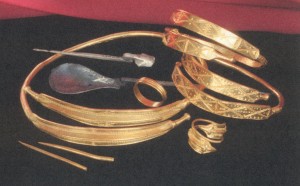
Burial gifts from Sweden’s richest burial mound; the female grave in Tuna, about AD 300. (Photo Gunvor Jansson, Statens historiska Museum, Stockholm)
– Archaeology
The archaeological material contains more male than female burials. Female graves may, however, be just as large and as richly equipped as the male graves, but the burial gifts are different. Female graves are equipped for female purposes. Instead of tools, weapons and hunting dogs, the women get household tools, textile equipment, jewelry and small dogs on their journey to the next life.
And – the richest Viking burial we know of is for a woman: The Oseberg Queen
WOMEN IN THE ARCHAEOLOGICAL MATERIAL
The sagas have little information about the first part of the Viking Age. It is first and foremost the burials that can give us information about gender roles in the Early Viking Age. The deceased is in many cases buried with burial gifts that indicate what the individual did while he or she was alive. Nevertheless, we must face the fact that archeology can also give us a picture that does not match reality.
Let us see if archeology can give us a hint about the development in women’s status:

“The Gausel Queen”. Stavanger. From around 850. One of the richest female burials in Norway, (Ill: Ragnar Børsheim )
– Late Roman and Migration Period (200 – 500 AD):
In the Late Roman and Migration Period, some centuries before the Viking Age, the tendency is that we several places in Scandinavia have more and richer female burials than male burials.
Male burials. The quality of the burials gifts seems to be reduced the older the buried man is.
Female burials. The richest burials belong to women between 50 – 60 years old. Thus; the status of women seems to increase with their age.
In the Iron Age, including the Viking Age, young girls were given away in marriage to create alliances between families. The most prominent gift a chieftain could give way was his own daughter. But – when we then see that the richest burials belong to grown up women, this strongly indicate that these women had a different foundation for their high status and power than just being a ”gift
– Viking Age
First part of the Viking Age: (9th Century) the distribution between male and female burials seems to be fifty-fifty.
Middle Viking Age (10th Century): Only every 4th grave can be certainly classified as a female burial.
To conclude
There are indications that women in the Viking Age had to achieve a higher status than men to get the kind of burial that shows up in the archaeological record. This may indicate that there was a decline in the status of women during the Viking Age.
Others believe that this may be due to changes in fashion, it may be that the oval broches that you normally use to determine women’s graves, gradually went out of fashion during the 900’s. Some have also suggested that the burnt burials at this time may have been more common for men than for women.
(In the latter part of the Viking Age, people were not buried with grave gifts because Christianity was introduced.)
(See also: Frans-Arne Stylegar: Kaupang- men and women)
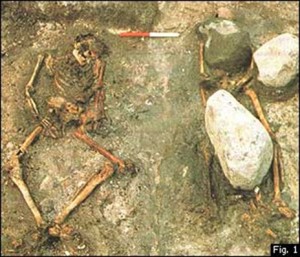
In this mixed burial from Gerdrup; Denmark (1981) we have a man with his hands and feet tied with a rope. He is probably a sacrificed male slave. At his side there is a woman buried with a spear and knife. (Christensen & Bennike 1983)
ARCHAEOLOGICAL CLASSIFICATION OF GENDER
The gender is normally identified by the burial gifts, partly because there seldom are much left of the skeleton in the graves.
Burials interpreted as male burials: Those that contain weapons, riding equipment, blacksmith’s tools, penannular brooches.
Burials interpreted as female burials: Those that contain objects like: Pair of oval brooches, disc brooches, necklaces, keys etc
Burials interpreted as mixed burials of one man and one woman: Those that contain both male and female objects.
In Scandinavia there are found many burials with both male and female artifacts including female oval brooches together with weapons. Such burials are normally interpreted as mixed graves of one man and one woman
What then, if a woman was buried with weapon a thousand years ago and we found her grave? She would probably be classified as a man!
TO CROSS THE GENDER BARRIERES?
But sometimes we find burials that force us to reconsider our idea of gender roles in the Viking Age. Sometimes the archaeological material indicates that both men and women could cross the gender barrier.
OSTEOLOGICAL INVESTIGATION OR DNA EXTRACTION
By using osteological investigation or DNA extraction on burials instead of archaeological determination, scientists have identified:
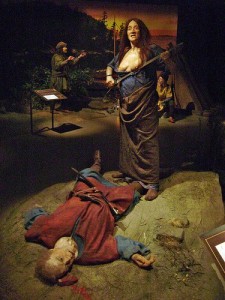
The sagas tell that women did go on some of the Viking expeditions. Here Freydis in Vinland, As exhibited in the Saga Museum, Iceland
– male skeletons with female burial gifts
– female skeletons with male burial gifts.
We even find men buried in female clothes. Why, were they transvestite Vikings, or were they shamans? We don’t know .
(See: Tina Lauritzen og Ole Thirup Kastholm: Transvesitite Vikings?)
WOMEN IN MALE-DOMINATED PROFESSIONS
Different sources tell about women that crossed the gender barriers and were occupied in “untypical female professions”.
Women as traders and travellers.
– The sagas
The sagas tell that women did go on some of the Viking expeditions.
The most notorious and frightening of these long distance travellers were Freydis, the daughter of Erik the Red. She initiated one of the Viking expeditions to Vinland. When natives attacked the family groups, the Viking men escaped. But Freydis, who was pregnant, bared her breasts, sharpened a sword against her chest, screamed a battle cry, and scared away the natives.
Another example is the settler Aud the Deep-Minded. In the same way as men, she led an expedition and found land in Iceland, and in the same way as men, she gave land to her companions. She behaved in every way as the family head.
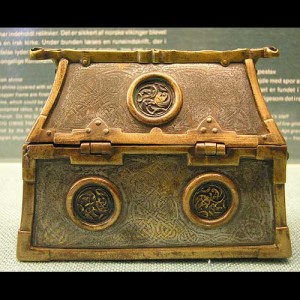
A Celtic relic-shrine found in Norway, With the runic inscription: “Ranuaik a kistu”.( Photo Christer Hamp )
– In archaeology
The archaeological material tells the story of Scandinavian women that reached places as far apart as Greenland and Russia. We tend to say that these women accompany their men, even though the sagas tells that women also initiated voyages.
A Celtic relic-shrine found in Norway, now in the museum of Copenhagen, have a runic inscription telling that Ranuaik a kistu (Ranveig owns this shrine). No male is mentioned in the inscription, but most people interpret it as a gift brought back to Norway of a travelling Viking for his woman. But perhaps Rannveig acquired the box while travelling herself?
In Scandinavia there are female burials with scales and weights. Such weights were used to measure precious metals and spices. The women in these burials could very well have been traders in their own right.
WOMEN AS VALKYRIES AND SHIELD-MAIDENS
Women that fought were in the Norse literature called vakyries or shield-maidens (skjoldsmøyer). There were several kinds of female warriors.
– Some were divine beings, like the valkyries sent by Odin to pick up the warriors that were slain on the battlefield.
– Others were half divine and half earthly. They were mortal women with supernatural power. We often meet them in the heroic sagas and poems as beautiful daughters of kings.
– Others again are described as just mortal,female warriors that dressed and fought as men.
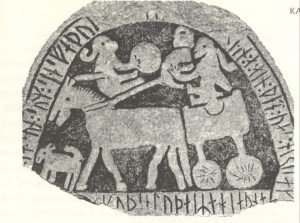
Woman driving a wagon, Picture stone, Gotland
The words “valkyries” and “shield-maidens” tend to be used synonymously, also in the Old Norse literature, but originally there must have been a difference:
Valkyries were probably originally used for the divine female fighters or rather “choosers of the slain”. (You never hear that Odin’s valkyries actually fight). The word valkyrie means “chooser of the slain” (Old Norse valkyrja, from the words valr = “the battle-slain” and kyrja = “chooser”)
Shield-maidens were probably originally used for mortal female fighters. The word shield-maidens means “woman with a shield/woman of battle” (Old Norse, skjaldmær, from the words skjald “shield” and mær = “maiden” )
The love-goddess Freya was looked upon as the greatest of all valkyries. She rode onto the battlefield in a chariot drawn by huge cats. Here she picked out half the men who had been slain in battle and took them back to her home Folkvang. The other half, those rejected by Frøya, was destined to live with Odin in Valhalla.
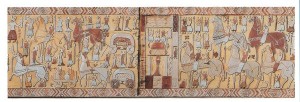
The Oseberg tapestry was found in the Oseberg ship burial. It tells a visual story of a religious procession. Many of the figures, also women, carry spears. Why? Are they female warriors? (Ill. Pinerest)
– Female warriors in Norse litterature
Norse sagas and scaldic poems tell colorful stories about female warriors. One of them is Sigrdrifa. Her name means “the one who gives victory”. She appears in the legend about Sigurd Favnesbane – (The Dragonslayer). Sometimes she is also called Brynhild.
Sigrdrifamál
Sigrdrivamal can be found in the Poetic Edda and in Codex Regius. Here we meet the valkyrie Sigrdrifa. Valkyries had the power to choose which side should win in a battle. Sigrdrifa once brought victory to a prince against Odin’s will. Odin punishes her to eternal sleep at the mountain Hindarfjell.
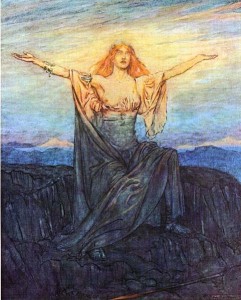
Brynhild (Sigrdrifa) Wakes up an greets the day. (Illustration Arthur Rackham)
Sigurd Favnesbane rides up to this mountain. He sees a great light, as if fire is burning, and the glow reaches up to heaven. When he comes closer, he sees a tower of shields. Inside the shield-tower Sigurd finds a person sleeping with all his weapons. Sigurd takes away the helmet and find that the warrior is not not a man – it is a woman with a mail-coat that seems to have grown to her flesh. Sigurd cuts the mail-coat with his sword, and Sigrdrifa awakes.
Sigurd asks her:
I have come here to ask if you can teach me wisdom. I have come to ask if you can teach me the magic of the runes.
Sigrdrifa then takes a huge drinking horn, fills it with mead, gives it to Sigurd and says. “Drink this my, friend, let us share this drink. Then I shall teach you wisdom”.
Then Sigrdrifa starts to pray. This is the only prayer left us from pre-Christian times. And it is not at all a prayer you would expect from a warrior.
We greet the Day
We greet the sons of Day
We greet the Night and her daughters.
Look at us now
with soft and tender eyes.
Bless us who are sitting here

“Valkyrie” av Peder Nicolay Aarbo, 1880, Nasjonalgalleriet
We greet the Gods
We greet the Goddesses
Greetings to you; Holy Earth
Give us the gift
of knowledge and wisdom,
and let us have hands that can heal.
(Sigerdrifamál)
Saxo, the Christian Danish chroniclar (ca 1200 AD), describes the shield maidens like this:
“There were once women in Denmark who dressed themselves to look like men and spent almost every minute cultivating soldier’s skills; (…..)
They put toughness before allure, aimed at conflicts instead of kisses, tasted blood, not lips, sought the clash of arms rather than the arm’s embrace, fitted to weapons hands which should have been weaving, desired not the couch but the kill, and those they could have appeased with looks they attack with lances“. (Books 1-9) —Saxo Grammaticus, History of the Danes, circa 1200.
– Foreign accounts of female warriors
Contemporary foreign accounts tell about female Viking warriors:

Riding woman with spear. From a pillar in the stave church at Urnes, Norway.
The Red Maiden that attacked Ireland
An Irish history book called The war of the Irish with the foreigners from the 12th century, tells a story about a warrior woman called: “he Red Maiden”. The book gives us a list of Viking fleets that attacked Munster in the 10th century. The last of these fleets were led by a woman called “The Red Maiden”.
Female warriors among the Vikings that attacked Byzantines in Bulgaria 971
A Greek historian (Johannes Skylitze ) from the late 11th Century, records that the Scandinavian ruler of Kiev attacked Byzantines in 971 and was defeated. The victors were astonished when they saw armed women among the fallen warriors.
– Female warriors in the art
The Oseberg tapestry was found in the Oseberg ship burial. It tells a visual story of a religious procession. Many of the figures, also women, carry spears. Why? Are they female warriors?
Another example is a woman with spear from a pillar in the stave church at Urnes, Norway. A third is a small figure of a woman with sword and shield that was found in Denmark in December 2012. She has been interpreted as the valkyrie.
– Female warriors in archaeology
There are also some burials that can hardly be interpreted as anything else than women buried as warriors.

Small figure of a woman with sword and Shield. Found in Denmark, December 2012. She has been interpreted as the valkyrie. (Odense Museum, Photo Wikimedia Commons)
The shield maiden from Aunvoll, Norway
One of them is called the shield maiden from Aunvoll or Aune, Nord Trøndelag. The grave was found when a farmer should cultivate new land. It contained the skeleton was of a woman, ca. 20 years old: She was buried with the complete equipment for a Viking warrior:
– a sword
– an axe
– two spears
– arrowheads
– the fragments of a shield
(See Lars F. Stenvik. Trøndelags Historie, bind 1. 2005)
The tiny shield-maiden from, Solør, Norway
Another burial was found in Solør, Norway in the year 1900. It is dated to the 10th century. The burial contained a skeleton of a woman, 18 – 20 years old. She was thin and gracefully built, with a neat cranium. She was not more than 1.55 metres high.
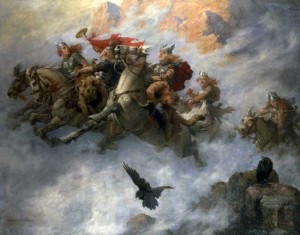
The ride of the Valkyries (Painting William T. Maud, 1890)
This tiny woman was fully equipped as a warrior with:
– a two egged sword
– an axe
– a spear
– 5 arrowheads
– a shield
– a skeleton of a horse
– a bridle
– some other tools
(See: Per Hernæs. Nickolay, Arkeologisk tidsskrift, Uio. C 22541 a-g)
Why were these women equipped with weapons for their journey into the other world? The most obvious interpretation is that they were female warriors? Or, could it be that the weapons symbolized something, perhaps power? Were the women sacrificed? Did the women participate in battles as sorcerers? Literary sources tell us magic could be used on the battlefield.
See:
Viking warrior women? Reassessing Birka chamber grave Bj.581
A female Viking warrior confirmed by genomics
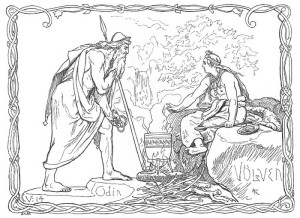
Odin and the volve (Lorentz Frølich, 1895)
THE VOLVE – SEERESS AND MAGICIAN
Volve : (ON vǫlva – plural vǫlur), sometimes anglicized to vala. Her I use the Norwegian word volve (plural volver).
The volve was a special kind of priestess or shamaness who used a magic called seið. She was a link between gods and humans. Sometimes the volve knew even more than the gods. In Volusspá. (The prophesy of the Volve) we hear that Odin himself comes to the volve to learn about the past and the future.
The word volve comes from from volr = which means ( magic)staff. We can translate volve to the “staff-carrier”.
– The power of seid
There different kinds of magic: seiðr, galdr, vardlokk, gandr, útiseta, fjölkyngi, fróðleikr, trolldómr, gerningar, ljóð, taufr …
It is first and foremost seiðr, galdr and vardlokk we hear about in connection with the volve.
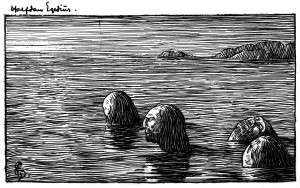
The wizards of Skrattaskjær, Avaldsnes (Illustrated by H. Egedius to Snorri’s sagas)
In the poem “Oddrun’s lament” we hear that galdr (magic song) is used during childbirth. Borgny is pregnant with her secret lover Vilmund. She almost dies during childbirth, but when her friend Oddrun starts to sing the galdr song, she manages to give birth to her twins.
Mythology tells that it was Freya, the love goddess, who taught Odin how to do seid, and even if both men and women could use this kind of magic, it was looked upon as a female skill.
Tacitus (ca 100 AD) says: “People of the Germanic tribes believe there are something sacred about women, something clairvoyant.”
– Men who did seid
There were, however, also men who did seid. In Olav Tryggvason’s saga, we hear that a ship loaded with sorcerers came in to Avaldsnes to cast spells over the king. He caught the sorcerers and tied them up at Skrattaskjær (The Sorcerers Skerry). When the tide came, the sorcerers drowned.
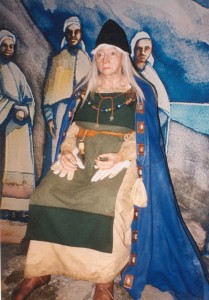
The volve Torbjørg as exhibited in the Sagamuseum, Island.
Men who used seið had to “cross” the gender barrier in a way that was not socially or morally accepted. They were “argr”, homosexual. Also Odin crossed the gender barrier and dressed up as a woman when he did the magic of seið. In Lokesenna (“Loki’s quarrel “) we hear that Loki mocks Odin by saying that he once dressed as a woman and did the magic of said as if he was a volve:
“But, it is said, thou wentest
with tottering steps in Samsö,
and knocked at houses as a Volve.
In likeness of a fortune teller,
thou wentest among people;
Now that, methinks, betokens a base nature.”
– The powerful volve known from sagas, poems and myths
Those who used seid could see into the past and the future. They had the power over life and death. They were respected but also feared. The volve could use magic songs like galdr, vardlokk and even herbs to put herself into a trance.
The best known description of such a volve is in “Erik the Red’s Saga”, where a volve called Torbjørg leads a magic ritual to stop a famine.
– The volve in the Archaeology
Until the last decades, volver have hardly been recognized in the archaeological material, perhaps because one did not know what to look for.
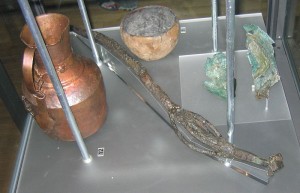
Finds from what could be a volve grave in Øland. Among the objects was a staff of iron. The corpse was dressed in a bear pelt. In her burial were also both human and animal sacrifices. Swedish Museum of National Antiquities, Stockholm. (Berig, Wikimedia Commons)
Among the objects used to identify a volve is above all: the staff which sometimes is of iron.
Ca 40 burials with staffs are discovered in Scandinavia. Most of them are placed in very rich graves which shows that the volve belonged to the highest level of society.
Other objects that are used to identify a volve burial can be; chairs, feathers (or bones from a bird), herbs, carts, amulets and “male” objects like weapons, perhaps also a horses and an dogs.
– The Oseberg queen or the Oseberg volve?
The best known, and richest, of all burials from the Viking Age is the Oseberg ship burial, dated to 834 AD. Two women were buried in the Oseberg ship.
In 2008 results of DNA and x-ray studies of the two women, revealed that the oldest lady was around 80 years old. (Per Hock). She has been called the Oseberg Queen, and people have believed that she was the grandmother of Norway’s first king, Harald Farihair. New research does not support this theory. She is too old. She also had a hormonal disease that gave her a masculine appearance. It is unlikely that she could have given birth to a child.
The youngest of them was about 50 years old when she died. It has been speculated if she was of a lower class than the older woman, and that she perhaps was a sacrificed slave.
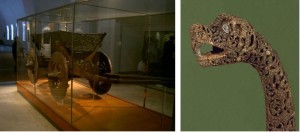
The Oseberg cart and one of the four animal head-posts. These may have been used In religious processions. (Poto Wikimedia Commons)
New investigation shows that she died of natural causes. There are no indications that she was of a lower class that the older woman.
A magnificent burial like the one in Oseberg will automatically give the image of royalty, and the burial has been called the burial of the Oseberg queen. The mysterious burial methods, however, indicate that one – or both women were volver.
– Indications of a volve burial in Oseberg
The Oseberg burial contained the most specific volve symbol: a staff. (- or was this a horn?)
Among the burials gifts were also:
– A beautiful carved cart: We know that such carts were used for religious processions.
– A tapestry that gave a figurative description of such a procession
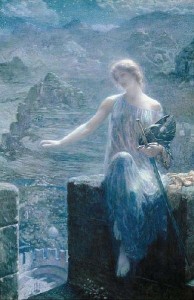
The Valkyrie’s Vigil (Edward Robert Hughes 1851 – 1914)
– Four animal-head posts and a rattle. It is possible that these objects were used in religious processions,
– A chair
– A peacock, which are only native in hot climate
– Feather from a pillow
– Seeds of cannabis found among the feathers.
WOMEN AS “SKALD-MAIDENS” OR POETS
Viking women could be magicians, perhaps hey also were warriors. Then you would of course expect that many women were poets or skalds. But there are very few. Among the ca. 250 skalds we know of, only 4 women are given the name skald in the sagas: Gunnhild kongsmor, Hild Rolfsdatter, Jorunn Skaldmøy, Steingunn. (See Judith Jesch, Women in the Viking Age, Woodbridge, Boydell, 1991)
We might look upon the art of making poetry as an appropriate “feminine activity”, but it seems that the Vikings looked upon this as a male skill. Perhaps because it was the chief good Odin that taught men to make poems. Another reason can be that the skalds were not only poets that had to entertain at the court. They were also historians, public relations agents and journalists. Some of them were warriors as well as skalds, and they often had to be in the midst of the events that they made poems about.
If, however, there had been more female poets and saga writers, we would perhaps have had a more nuanced picture of the Viking Age women.
Back

